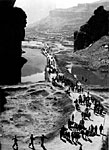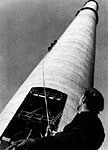 Die
Fotografie was read internationally, in communist as well as capitalist
nations. Moreover, although it focused on work that underwrote its
aesthetic agenda, Die Fotografie regularly presented images
by historical and contemporary photographers from throughout the world.
The photographs presented in Recollecting a Culture, however,
are limited to artists from East and West Germany, the USSR and its
European satellites, China, and communist Southeast Asia. My hope
was that by narrowing its scope, Recollecting a Culture would
be made to illustrate that, within the context of a divided nation
and an evolving socialist aesthetic, East German photography grew
from a strain of Soviet socialist realism to a distinct critical practice,
and that Die Fotografie played a crucial, if not always positive,
role in that development.
Die
Fotografie was read internationally, in communist as well as capitalist
nations. Moreover, although it focused on work that underwrote its
aesthetic agenda, Die Fotografie regularly presented images
by historical and contemporary photographers from throughout the world.
The photographs presented in Recollecting a Culture, however,
are limited to artists from East and West Germany, the USSR and its
European satellites, China, and communist Southeast Asia. My hope
was that by narrowing its scope, Recollecting a Culture would
be made to illustrate that, within the context of a divided nation
and an evolving socialist aesthetic, East German photography grew
from a strain of Soviet socialist realism to a distinct critical practice,
and that Die Fotografie played a crucial, if not always positive,
role in that development.
To
American eyes, the methods and subjects of East German photography
may appear formulaic and cliched.  Writing
on behalf of the ZKF, in 1960 Gerhard Henniger listed the themes most
worthy of pursuit by East German photographers as "[one's] own
practice within production, his life in the brigade, within the family,
his holidays, his recreation, his sports [...] socialist naming and
marriages, brigade evenings and cooperative meetings." (DF-8/60,
p. 292) Yet what we regard as banalities, images of the ordinary,
are captured here with complete conviction. In fact, what distinguishes
so much of the work presented in Die Fotografie is its simultaneous
rejection of style and embrace of issues, such as health, work, youth
and age, and leisure, all pictured though the lens of cultural politics.
Writing
on behalf of the ZKF, in 1960 Gerhard Henniger listed the themes most
worthy of pursuit by East German photographers as "[one's] own
practice within production, his life in the brigade, within the family,
his holidays, his recreation, his sports [...] socialist naming and
marriages, brigade evenings and cooperative meetings." (DF-8/60,
p. 292) Yet what we regard as banalities, images of the ordinary,
are captured here with complete conviction. In fact, what distinguishes
so much of the work presented in Die Fotografie is its simultaneous
rejection of style and embrace of issues, such as health, work, youth
and age, and leisure, all pictured though the lens of cultural politics.
 While
acknowledging the humanism of The Family of Man and the work
of the Magnum cooperative, the theorists of socialist aesthetics rejected
the decisive moment as a mere formalist novelty. The stylistic elements
of "critical realism," as such favored Western photography
was called, could not disguise its basis in class values. "Despite
all critique of bourgeois society, the bourgeois class point of view
is not abandoned," Dr. F. Herneck wrote in 1960. (DF 8/60, p.
308) Socialist realism, by contrast, with its roots in the workers
struggle and its ideals in the collective vision, represented a higher
artistic achievement.
While
acknowledging the humanism of The Family of Man and the work
of the Magnum cooperative, the theorists of socialist aesthetics rejected
the decisive moment as a mere formalist novelty. The stylistic elements
of "critical realism," as such favored Western photography
was called, could not disguise its basis in class values. "Despite
all critique of bourgeois society, the bourgeois class point of view
is not abandoned," Dr. F. Herneck wrote in 1960. (DF 8/60, p.
308) Socialist realism, by contrast, with its roots in the workers
struggle and its ideals in the collective vision, represented a higher
artistic achievement.

